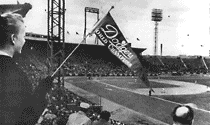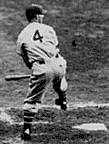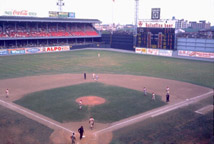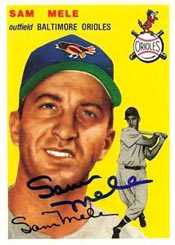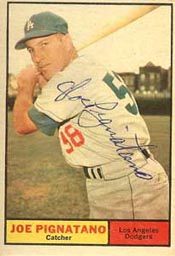|
CONTENTS
Power
Hitting Facts
Two
Grand Slams in One Game – by a Pitcher!
Jersey
City Dodgers?
1936
vs. 2000
A
Cycle in Four Batters
Unique
Record
Most
Hits in a Shutout
Stadium
Swaps in Boston
Lousy Way to End a Career
Two All Star Games Each Year
Female Umpires
Willie's Greatest Catch
Baseball
Did You Know – I
Baseball
Did You Know – II
Baseball
Did You Know – IV
Baseball
Did You Know – V
Baseball
Did You Know – VI
Baseball
Did You Know – VII
Baseball
Magazine
Golden Rankings Home
Top
of Page |
Baseball
Did You Know? – III
|
- Mel
Ott
hit 511 career home runs, all for the New
York Giants. Not one of them was hit in Shibe
Park in Philadelphia. This may be because Mel
was a line drive hitter and, as you can see from the picture,
Shibe Park (later Connie Mack Stadium) had a high right field
fence.
- During
1968, Frank Howard of the Washington
Senators hit 10 HRs in 20 at bats. He ended
the season with 44 round-trippers.
June
8, 1961: The Kansas City Athletics
hit three consecutive triples in a five-run third inning against
the Yankees. On
the same day, the Milwaukee
Braves slugged four straight HRs in a loss to
the Reds at Crosley
Field, 10-8. Ed Mathews, Hank Aaron,
Joe Adcock, and Frank Thomas
belted the HRs.
Speaking
of consecutive triples, Earle Combs of the Yankees
hit a record-tying three straight triples on Sept. 22, 1927 against
the Tigers in Yankee
Stadum. In the same game, Babe Ruth hit his 56th
HR (on his way to the record of 60 that stood for 34 years) as
New York edged Detroit
8-7. |
|
|
Two
Grand Slams in One Game – by a Pitcher!
|
|
On
July 3, 1966, Tony Cloninger achieved a feat that
no pitcher before or since has matched. He hit two grand slams in
a game for the Atlanta Braves
against the San Francisco Giants
at Candlestick Park. He also had an RBI single in the 17-3 rout.
His 9 RBI broke the record of 7 for a pitcher by the Yankees'
Vic Raschi in 1953.
Cloninger's
first clout capped the 7-run first inning and came off Bob
Priddy, who had replaced starter Joe Gibbon.
When Tony came up in the fourth inning with the
sacks full, C Joe Torre was on third. 3B coach
Grover Resinger told him he could "feel
it": Tony was going to set a record by hitting
another slam.
No
way, said Joe. "I've been up five years,
and I've never seen anyone come close to hitting two in one game."
One pitch later, lefty Ray Sadecki tried a fastball,
and Cloninger sliced it toward RF. CF Willie
Mays and RF Jesus Alou raced toward
the ball, only to watch it sail over the fence. Resinger went wild at third. In the 90-year history of the National League,
no player – much less a pitcher – had ever crashed
two slams in one game.
Cloninger
finished the 1966 season with a 14-11 record for the fifth place
Braves. He hit a
total of five four-baggers that year and 11 for his career. The
righty compiled a 113-97 record in his 12-year career with
Milwaukee/Atlanta,
Cincinnati, and
St. Louis. |
The
Brooklyn Dodgers played seven "home"
games at Roosevelt Stadium in Jersey City in 1956 and seven
more in 1957. It was part of owner Walter O’Malley's
campaign to convince New York City officials that there was
an urgency in finding a solution to the aging Ebbets Field problem.
He had sold 43-year-old stadium to the city in October, 1956
and leased it back for three years to give him time to build
a new stadium. By playing in Jersey City, he also hoped to ignite
enough fan interest to persuade New Jersey officials to build
him a stadium.
Roosevelt
Stadium, a 1937 WPA project named for FDR, seated 24,500, which
was only 7,400 less than Ebbets Field. The New
York Black Yankees played some games there in
the 1940s. On April 18, 1946, Jackie Robinson
took the field for the Montreal
Royals, the Dodgers' AAA affilate,
against the New Jersey Giants
in the opener of the International League season. Robinson
thus became the first African-American player in professional
baseball in the modern era. The Giants had
sold 52,000 tickets for the game, more than double stadium capacity.
Jackie was lustily booed in his first plate
appearance. However, he had a sensational debut: three singles,
a three-run HR, and two SBs in a 14-1 romp over the home team.
Little did anyone know that Jackie would return
10 years later with the Dodgers.
In
1956 the Dodgers were coming off their first
world championship. Yet they had drawn only 1,033,589 at Ebbets
Field during the 1955 season. Although that figure ranked second
in the league, O'Malley didn't consider it
enough to keep the franchise healthy at its present location.
Some
highlights of the Dodger games in Jersey
City in 1956-7.
- 12,214
brave cold, rainy weather to watch the Dodgers
nip the Phillies 5-4 in the first MLB game at Jersey City. This turns out
to be the largest daytime crowd the Dodgers
will draw in New Jersey for their 14 games there.
- Carl
Furillo
hits the Dodgers' first home run at Roosevelt
Stadium on July 25, 1956. as Newcombe outdeals
Brooks Lawrence of the Reds,
2-1.
- August
15, 1956: Willie Mays of the New
York Giants clouts the only HR ever
hit completely out of the park to beat the Dodgers
and Don Newcombe 1-0 before 26,385.
This is Brooklyn's only loss in the
seven New Jersey games that season.
-
The Dodgers average 21,196 fans per game
in Jersey City in 1956, as compared to 15,217 at Ebbets
Field, an increase of 40 percent. Their total for the
season is 1,213,562 (2nd in the 8-team NL).
- The
Dodgers draw even more fans for their
seven games in Jersey in 1957, compiling a 4-3 record.
The total home attendance for the season is 1,028,258
(fifth in the league).
- Don
Drysdale pitches the first of his 49 shutouts
on June 5, 1957 in Jersey City, beating the Cubs,
4-0.
- September
3, 1957: Brooklyn plays its last game
in New Jersey, losing to the Phillies
3-2 in 12.
Despairing
of getting a new stadium in New York or New Jersey, O'Malley
moved his team to Los Angeles for the 1958 season. Roosevelt
Stadium was demolished in 1985.
|
It
is instructive to compare the rosters of the 1936 New
York Yankees with the players on the 2000 Yankees.
| 1936 Yankees |
Position |
2000 Yankees |
| 6'
186 lbs |
Pitchers |
6'3"
204 lbs |
| 5'11"
180 |
Catchers |
6'2
1/2" 200 |
| 5'11"
171 |
Infielders |
6'1"
190 |
| 6'
180 |
Outfielders |
6'3"
206 |
| 6'
181 |
Team
Average |
6'2"
200 |
Here's
some other comparisons of Depression-era baseball to today's
game.
-
In
1935, the eight American League teams averaged 87
complete games in a 154-game schedule. The National League
averaged 67 complete games per team.
-
In
1941, AL staffs still averaged 71 complete
games. The NL averaged 66.
-
In
2001, AL pitchers completed an average of 7.6
games per team. The NL average was 8 complete
games per team.
|
Sunday,
June 6, 1993: Detroit defeated California,
11-4, at Tiger Stadium. In the third inning, the Tigers pulled off a rare feat by hitting for the cycle in a four-hitter
span. Here's what happened with one out against RHP John
Farrell.
Of
the five Angels pitchers to take the mound that day, the only one to retire Detroit in order
was IF Rene Gonzalez, who had not pitched since
American Legion ball.
|
| Unique
Record |
|
|
Sam
Mele was a star college basketball player during the early
1940s, a major league baseball outfielder from 1947-1956 and later
a major league manager.
Sam owns a unique "record." He is the only person to
accomplish all three of these feats.
-
Lead
his college team in scoring in a NCAA Tournament game –18
points in 1943 for New York University.
-
Lead
the American League in doubles with 36 in 1951 with the Washington
Senators.
-
Manage
an American League team to a pennant - 1965 with the Minnesota
Twins.
|
What
is the most hits given up by a pitcher who threw a complete
game nine-inning shutout?
-
September
14, 1913: RHP Larry Cheney of the Chicago
Cubs shutout the New
York Giants despite surrendering 14 hits.
The Giants had a hit in every inning but only one runner reached third
base. Three of John McGraw's men helped Cheney by getting caught stealing while
another was thrown out trying to stretch a single into a
double. Cheney finished the season 21-14,
the most wins (by 8) for the third place Cubs.
-
July
10, 1928: The Cleveland Indians
matched the mark for futility with 14 hits without scoring
against Washington
pitcher Milt Gaston. Gaston,
who two years earlier had hurled a 12-hit whitewash for
the St. Louis Browns against the Red Sox,
survived six leadoff hits and stranded five Indians on third. Gaston's mark for '28 was only
6-12 for the 4th-place Senators.
|
The
1914 "Miracle Braves,"
who came from last place in mid-July to win the pennant
with a sensational 34-10 finish, started the World Series
with two games at the Philadelphia
Athletics' Shibe Park. When the Series moved
to Boston for Game Three, the Braves did not play at their own field, "a shabby, run-down
stadium" called South
End Grounds. Looking like the grandstand for a medieval
jousting tournament, it had been rebuilt in 1894 after a
fire and seated only 6,800. Instead, Boston's
home games were played at the Red Sox' Fenway Park, which had opened in 1912.
35,520 attended the Braves'
5-4 victory in Game Three, and another 34,365 saw them sweep
the Mackmen
the next day.

Fenway Park during 1914 World Series
1915
again produced a Boston-Philadelphia Fall Classic. Only
this time it was the Boston
Red Sox against the Philadelphia
Phillies. Again the Series began in Philadelphia,
at the Phillies'
band box called Baker
Bowl, whose capacity was increased to 20,000 with the
addition of bleachers on the field in right-center. When
the Series came to Boston, the Braves
returned the favor and allowed the Red Sox to play in their new Braves
Field, built with the profits from the glorious 1914
season. 42,300, a new Series record, saw the Red Sox beat the Phillies 2-1. Then 41,096 watched Boston win the next day by the same score. The Red Sox closed out the Phils in the fifth game in the City of Brotherly Love.
The Red Sox played their home games at Braves Field again during the 1916
World Series. In Game 2 there, 21-year-old lefty Babe
Ruth, in his second full season with the Bosox,
defeated the Brooklyn Robins
2-1 in 14 innings, allowing only six hits. Bostonagain prevailed in five games.
|
Lousy Way to End a Career
Joe
Pignatano had an undistinguished career in MLB.
In five full seasons, the C played for four different
teams, most notably the Los Angeles Dodgers
from 1958-1960. (He played in 8 games in the Dodgers'
last year in Brooklyn in '57.) He appeared in one game
of the 1959 World Series against the White Sox
without an at-bat. His career batting average is .234.
However, he does claim a distinction that no one else
can match, albeit a dubious distinction.
On
September 30, 1962, the hapless expansion New
York Mets played their final game before 3,960
fans at Wrigley Field. Casey Stengel's
"ball club" was about to wrap up one of the
worst seasons ever at 40-120, the first team to finish
in 10th place in the National League since there had been
only eight teams before 1962. Amazingly, the Chicago
Cubs were about to become the first NL team to
finish ninth. Their 59-103 record put them behind the
other expansion team, the Houston Colt 45s (64-96).
|
|
In
the 8th inning of that last game, Sammy Drake
and Richie Ashburn led off with singles
for the Mets off Bob Buhl.
These turned out to be last ML at-bats for both players
(Drake because he was no good and Ashburn,
a future Hall of Famer, because he was retiring). Up stepped
Pignatano. "Piggy"
hit a broken bat shot to the right of 2B that at first seemed
to be a hit. However, 2B Kenny Hubbs caught
the ball and tossed to Ernie Banks at first
to double up Ashburn. Ernie
then threw it to SS Andre Rodgers for the
third out. Pignatano retired after the
season, making him the only player to ever hit
into a triple play in his last ML plate appearance.
|
| Two All Star Games Each Year
For four years in a row, 1959-1962, major league baseball staged two All Star games. The second game was added to raise money for the players' pension fund and for other causes but also to rejuvenate interest in the game. Here is a summary of the eight "doubleheaders." Click the date for details on each game from Baseball-Reference.com, including starting lineups, rosters, and play-by-play.
Year |
Date |
Site |
Attendance |
Winner |
Winning Pitcher |
Losing Pitcher |
1959 |
July 7 |
Forbes Field, Pittsburgh |
35,277 |
NL 5-4 |
Johnny Antonelli, SF Giants |
Whitey Ford, Yankees |
| |
Aug. 3 |
Memorial Coliseum, Los Angeles |
55,105 |
AL 5-3 |
Jerry Walker, Orioles |
Don Drysdale, LA Dodgers |
1960 |
July 11 |
Municipal Stadium, Cleveland |
30,619 |
NL 5-3 |
Bob Friend, Pirates |
Bill Monbouquette, Red Sox |
| |
July 13 |
Yankee Stadium, New York |
38,362 |
NL 6-0 |
Vernon Law, Pirates |
Whitey Ford, Yankees |
1961 |
July 11 |
Candlestick Park, San Francisco |
44,115 |
NL 5-4 |
Stu Miller, Giants |
Hoyt Wilhelm, Orioles |
| |
July 31 |
Fenway Park, Boston |
31,851 |
1-1 tie |
––––– |
–––– |
1962 |
July 10 |
R.F. Kennedy Stadium, Washington |
45,480 |
NL 3-1 |
Juan Marichal, Giants |
Camilo Pascual, Minnesota Twins |
| |
July 30 |
Wrigley Field, Chicago |
38,359 |
AL 9-4 |
Ray Herbert, White Sox |
Art Mahaffey, Phillies |
Notes:
- In 1960, the games were both played during one All-Star break for all teams. In the other three years, the games were at least 20 days apart.
- Commissioner Ford Frick had discontinued fan voting for the All Star starting lineups after Reds fans stuffed the ballot boxes in 1957. The players, managers, and coaches of each league chose the teams for the next 12 years, including the four years of the double games.
- The rosters were essentially the same for both games each year although some changes were made due to injury, especially when the games were several weeks apart. Also, the managers (the skippers of the previous year's pennant winners as has always been the case) were free to choose the starting lineup for each game.
- Game #1 in 1959 provided a contrast in results from two future Hall of Famers. Don Drysdale of the Dodgers threw three spectacular innings: no hits, no runs, no walks, and four strikeouts. On the other hand, the Yankees' Whitey Ford allowed three hits, two runs, and a game winning triple by Willie Mays in only one-third of an inning. Drysdale was rewarded for his effort by being given the starting assignment in Game #2 also by Manager Fred Haney of the Milwaukee Braves.
- Baseball reverted to a single All Star game in 1963 because the owners felt two a year diluted interest in the game.
|
| Female Umpires
There have been six female umpires in the history of the minor leagues but none in the major leagues, although several women have called spring training games.
 Ria Cortesio
Ria Cortesio |
- In 1972, secretary Bernie Gera became the first female umpire when she won a five-year-long anti-discimination lawsuit with the New York State Human Rights Commission. Hired at the Class A level, she lasted exactly one game. When she reversed a call, the Auburn manager yelled that she had made two mistakes: "The first was you put on that uniform and came out here as an umpire. Your second mistake was you left the kitchen." When the game ended, Gera resigned.
- Pam Postema lasted 13 years in the minors, the last seven of which were at AAA. She came close to making the majors, as evidenced by the fact that she called ML spring games for two years. However, she was not rehired after 1989, supposedly for ejecting too many players. She filed a sex-discrimination suit against the Triple-A alliance that was settled out of court. She wrote a book about her experiences with the interesting title You've Got to Have Balls to Make It in This League.
- The last female professional umpire, 5'10" Ria Cortesio, was released after the 2007 season. She had worked nine years, including five at the AA level. On March 29, 2007, she became the first woman since Postema to umpire an MLB exhibition game.
|
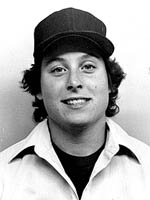 Pam Postema
Pam Postema |
|
To most baseball fans, it is simply "The Catch." But to the man who made it, Willie Mays, it isn't the greatest of his career, maybe not even in the Top Ten. Of course, we're referring to Willie's catch off Vic Wertz in the eighth inning of Game One of the 1954 World Series in the Polo Grounds.
Mays ranks a diving, backhanded catch he made in Ebbets Field off Dodger IF Bobby Morgan in 1952 his best. "I was playing him toward right center, and he pulled it more than I expected. I just left my feet, stretched out, and the ball hit in the my glove. It must have knocked the wind out of me, because the next thing I remember, Jackie [Robinson] and Leo [Durocher] were looking down at me when I opened my eyes."
Regarding the Wertz catch, Willie didn't consider it all that great because he never had any doubt he would catch the ball. In fact, as he raced toward the wall, he was thinking that he had to get the ball back to the IF as quickly as possible or Larry Doby might tag up and score all the way from second. That is why you see him whirl immediately and throw the ball so quickly. Doby did go to third but was stranded to leave the score 2-2.
Since Joe DiMaggio's death in 1999, Willie has assumed the title of "Greatest Living Ballplayer." One wonders what Willie's totals might have been had he not missed most of the '52 season and all of '53 in the military during the Korean War. He, and not Hank Aaron, might have been the first to break Ruth's 715 career HR mark. He had 660 and probably would have hit at least 60 more in the two years he missed.
|
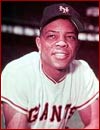
Willie Mays
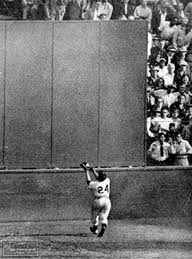
Mays' Catch off Vic Wertz in 1954 World Series
|
Reference: "Where Are They Now? Willie Mays," Sports Illustrated, July 14-21, 2008
|
|
